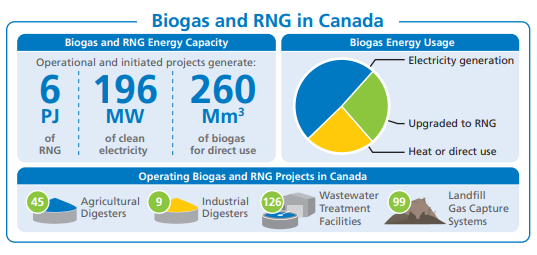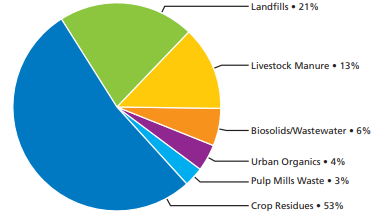Adriana Da Silva Bellini
Avocate
Article
15
Human beings inherently produce waste and this reality is an opportunity to create value from what would otherwise be an uncomfortable byproduct of our civilization, particularly as our nation aims to achieve net-zero emissions by 2050 (or sooner).
Biogas is produced from organic materials and is a renewable source of methane (the main ingredient in natural gas). It is used for heating and cooling, electricity production, and notably, can be refined into renewable natural gas (RNG) and transported in existing natural gas pipelines.[1] RNG is a direct substitute for fossil-based natural gas.[2] It can also be compressed and used as a vehicle fuel.
These attributes make it a very attractive green fuel source.
Using specialized equipment, commonly an anaerobic digester, organic substances such as agricultural byproducts and landfill gas are broken down in a process known as anaerobic digestion.
There are five main sources of feedstock for biogas systems:
Anaerobic digestion also produces digestate, a nutrient-rich substance with direct agricultural applications.
Biogas is an incredibly flexible source of fuel. Unlike other sources of renewable energy, it delivers a reliable flow of energy regardless of weather conditions. It can produce power during peak system demand, be dispatched down, and stored during energy surplus periods.[3]
In 2020, Canada produced 6 million gigajoules (6 PJ) of energy through RNG, 260 million m3 of biogas for heat, direct use and fuel to provide 196 megawatts of clean electricity capacity.[4]

Source: Canadian 2020 Biogas Market Report (2021), page 2.
According to figures published by The Canadian Biogas Association, this represents only about 13 per cent of easily available biogas energy potential in Canada.[5] These figures suggest a massive opportunity and potential for growth in the sector, particularly utilizing organic materials such as crop residues and landfills.[6]

Source: Canadian 2020 Biogas Market Report (2021), page 9.
Biogas offers the benefit of significantly reducing greenhouse gas emissions. It does this in two ways:[7]
Biogas also generates co-products during anaerobic digestion and upgrading (cleaning) into RNG , which can be used as a substitute to synthetic fertilizers.
Other benefits include:
According to the Canadian Biogas Association, utilizing the full potential of biogas development in Canada would contribute to 1,800 separate construction projects with a capital investment of $7 billion and an overall economic spin-off of $21 billion to the Canadian economy.[8] This development would create thousands of short-term and long-term construction jobs and new and expanded biogas companies and biogas support companies. This represents an opportunity to diversify farms, businesses, and communities beyond conventional revenue sources.
Canadian biogas experienced a decade of rapid growth from 2011 to 2020, with an almost 50 per cent jump in operating biogas projects across the country.[9] As of 2020, there were 279 biogas facilities in Canada. The largest of these facilities utilize agricultural waste and landfill materials.
Biogas and RNG facilities exist in every province across the country. The largest share of biogas growth is being driven by specific government policies, regulations, and programs in British Columbia, Quebec, and Ontario.[10]
Municipalities such as Hamilton, Ontario[11] and Surrey, British Columbia, have been using RNG to power transit and waste fleets.
Surrey's RNG plan launched in 2012 and consists of four main steps:
As such, RNG closes the carbon loop on waste collection in Surrey.
The Canadian Biogas Association cites the following key barriers to biogas and RNG development in Canada[13]:
However, these barriers are being steadily addressed. Strong governmental policy is helping to provide the support and attendant certainty necessary for the industry to make long-term investments.
On June 4, 2021, the Canadian government announced the Agricultural Clean Technology Program (ACTP).[14] This program grants qualified farmers and agribusiness access to a total of $165.7-million in funding to help develop and adopt clean technologies to reduce GHGs and enhance the competitiveness of the latest green technologies.
The ACTP carves out $10 million in funding for the adoption of clean energy projects over the next two years, as well as an additional $50 million to support the research and innovation of clean energy technologies until 2028.
Canadian provinces are also actively involved in developing policy incentives to encourage the adoption of biogas. Ontario, for example, lists several programs which can be found here. Ontario's Growing Forward 2 (GF2) program supports projects that build capacity in the Ontario agri-food industry.[15] Development of the feasibility and design for a biogas project may qualify for project funding. Organizations and collaborations could receive as much as 75 per cent in cost sharing.
A summary of Canadian funding and incentive programs for biogas can be found on biogasassociation.ca.
Further policy, public awareness and educational support is provided by the Canadian Biogas Association (CBA), a member-driven industry association that caters to the diverse needs of the biogas sector to build a strong, robust biogas and RNG industry in Canada. Gowling WLG is proud to be a member of the CBA.
The 150 companies that the CBA represents span the interests of biogas and RNG production, ranging from agriculture to municipal interests and includes technological and technical experts that assist in the design, construction, and expansion of biogas infrastructure across Canada. This extensive network of interests helps support the biogas industry collectively and provides a strong voice to advocate for opportunities, programs, and policies and inform and connect like-minded companies and individuals.
Learn more about biogas on our latest podcast with Alison Gray and Alex Sadvari of Gowling WLG's BioEnergy Group and CBA Executive Director Jennifer Green.
This article was prepared with the assistance of Andre Matheusik a summer law student in Gowling WLG's Calgary office.
[1] Canadian Biogas Study Summary (2013), page 1.
[2] Canadian 2020 Biogas Market Report Summary (2021), page 3.
[3] Canadian Biogas Study Summary (2013), page 11.
[4] Canadian 2020 Biogas Market Report Summary (2021), page 3.
[5] Canadian 2020 Biogas Market Report Summary (2021), page 9.
[6] Canadian 2020 Biogas Market Report Summary (2021), page 10.
[7] Canadian 2020 Biogas Market Report Summary (2021), page 4.
[8] Canadian Biogas Study Summary (2013), page 4.
[10] Canadian 2020 Biogas Market Report Summary (2021), page 5.
[13] Canadian 2020 Biogas Market Report Summary (2021), page 10.
CECI NE CONSTITUE PAS UN AVIS JURIDIQUE. L'information qui est présentée dans le site Web sous quelque forme que ce soit est fournie à titre informatif uniquement. Elle ne constitue pas un avis juridique et ne devrait pas être interprétée comme tel. Aucun utilisateur ne devrait prendre ou négliger de prendre des décisions en se fiant uniquement à ces renseignements, ni ignorer les conseils juridiques d'un professionnel ou tarder à consulter un professionnel sur la base de ce qu'il a lu dans ce site Web. Les professionnels de Gowling WLG seront heureux de discuter avec l'utilisateur des différentes options possibles concernant certaines questions juridiques précises.